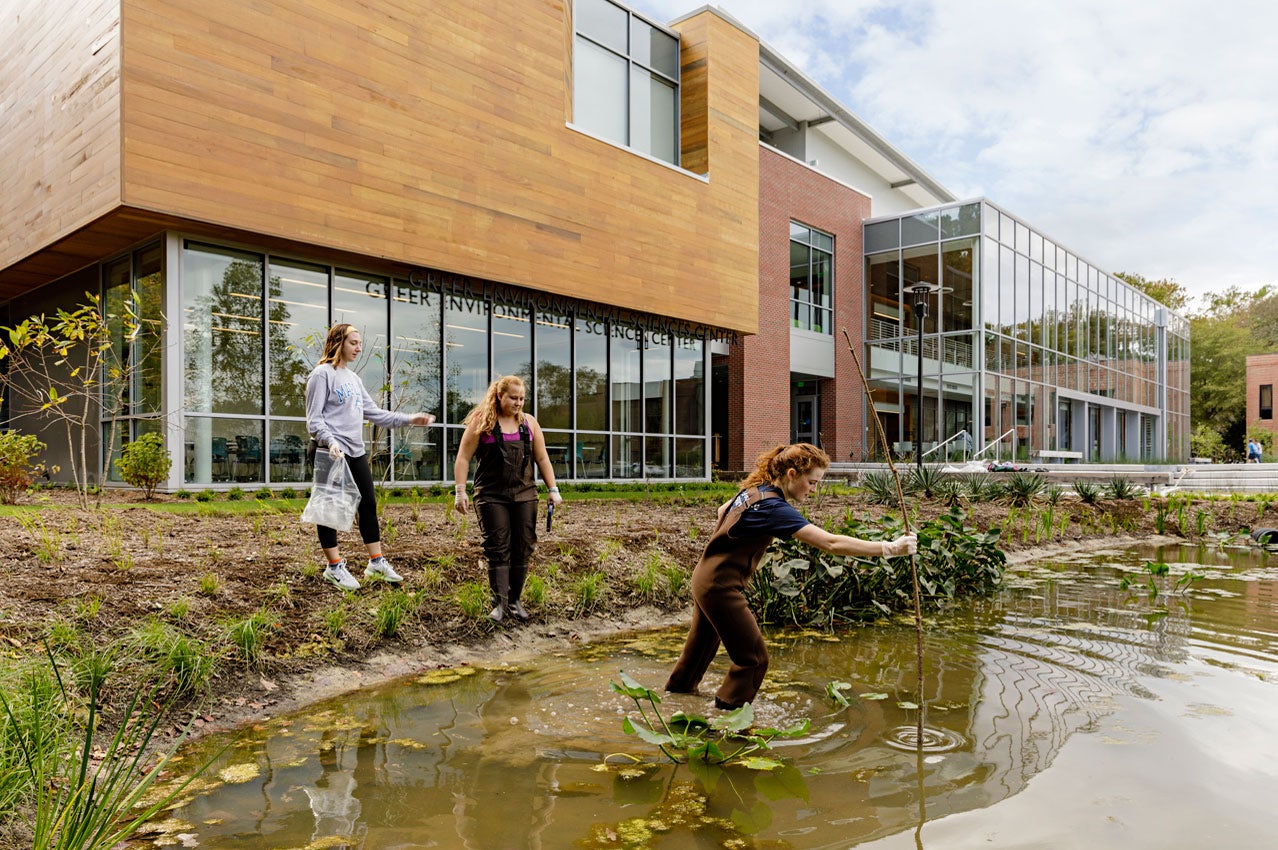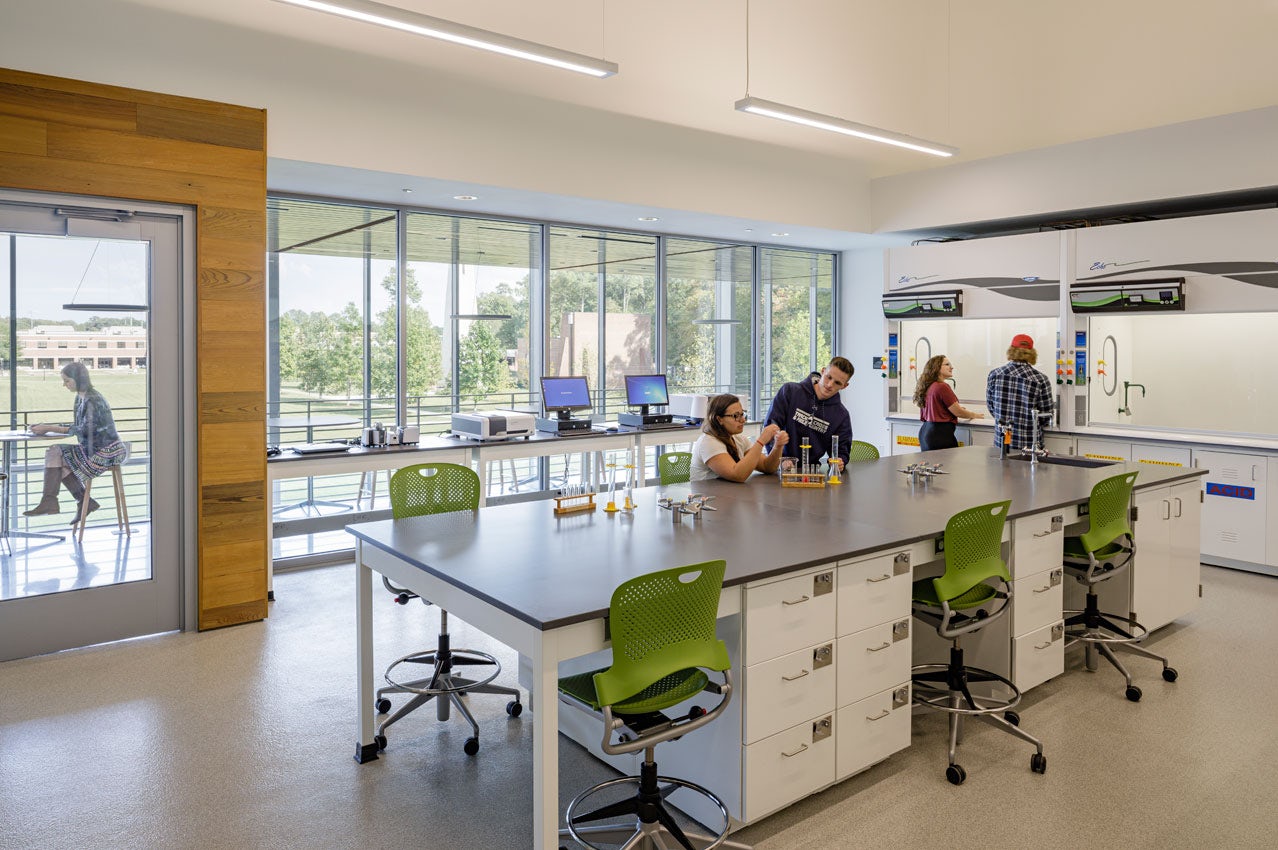Recently certified LEED Gold, the Greer Environmental Sciences Center elevates Virginia Wesleyan University’s commitment to environmental sustainability and advocacy for a thriving, cross-disciplinary science program. The Chesapeake Bay Foundation (CBF) has named Virginia Wesleyan University (VWU) a 2017 Conservationist of the Year—honoring the university’s commitment to educating the next generation of Chesapeake Bay leaders. In addition to expanding undergraduate research opportunities and raising the university’s campus and student profile, the opening of the Greer Center aligns with the Chesapeake Bay Foundation’s mission, according to CBF president Will Baker, to “help students appreciate the wonders of the Bay and become our future environmental stewards.”
A Gateway to the Sciences
Completing the campus’ main quadrangle, the Greer Center creates an inspiring sense of place that physically and programmatically bridges disciplines, engages a diversity of students in the sciences, and invites the university community and regional partners to study local ecology through immediately-accessible, hands-on opportunities. Pedagogically, the building fosters an immersive approach to inspiring research opportunities on a small liberal arts campus. The Center locates its core labs at the center of the building and connects everything to the lab experience through transparent details and a pathway brimming with local flora and fauna. Bald cypress trees, native plantings, a green roof, and constructed wetlands offer wildlife sightings, such as a recent hatching of baby snapping turtles—bringing environmental study and stewardship vividly to life for students.
By celebrating place-based investigations, the building encourages a highly participatory environment that brings students into the magnetic and active orbit of faculty mentorship and local research opportunities. A gateway to the sciences on campus, the Center also extends its mission outward to inspire stewardship of the Chesapeake Bay and forge research opportunities with regional partners such as the Chesapeake Bay Foundation, the Virginia Aquarium, the Virginia Institute of Marine Science, and the Norfolk Botanical Garden. Each programmatic adjacency in the building was intentionally designed to connect—teaching to learning, research to partnerships, students to the environment, building to campus, and the local context to global perspectives on stewardship and care for the environment.
Living Laboratory
VWU Associate Provost and Professor of Biology Maynard Schaus describes how the building has become a “living laboratory” where “many of the building’s features tie to specific courses” and “specific design features tie to specific faculty members’ research projects.” Director of Undergraduate Research and Professor of Marine Biology Soraya Bartol echoes this sentiment: “the Center creates a collaborative, student-centered learning environment with the flexible space needed for undergraduate research that goes beyond typical disciplinary boundaries.” For instance, Dr. Bartol’s Chesapeake Bay Fish Lab, visually and physically connected to her Marine Biology teaching lab, studies marine organisms and water samples collected from a 45-foot research vessel named Ocean Explorer—jointly owned and used by VWU and the Virginia Aquarium. “The building’s synergies provide students with unparalleled access to research opportunities," shares Dr. Bartol.
Student and faculty continue to find new and interesting sources of research, inspired by the building. “One of our faculty members requested flow meters installed in stormwater drain pipes, so that our students could compare runoff from the green and conventional portions of the roof and examine how mercury is transformed in the adjacent stormwater ponds,” explains Dr. Schaus. In a physics course, students are asked to collect micrometeorites that fall on the green roof and study them with the aid of the building’s electron microscope. On a routine basis, students use the building dashboard system, displayed throughout the building, to track the effectiveness of the geothermal heat exchangers, the solar photovoltaic panels, and the overall energy efficiency, compared to a conventional building.
These investigations have led to larger collaborative research efforts and grant submittals. “We’ve had some faculty and students co-author manuscripts and get their work published, which is rare at a small liberal arts institution. We want to continue to foster those kinds of opportunities for future grant efforts,” shares Dr. Schaus.
Environmental Stewardship of the Chesapeake Bay
The Greer Center creates an immersive science experience for everyone on campus, not just science majors. And within the School of Mathematics and Natural Sciences specifically, all fields were invited to participate in the planning of the building. “We wanted to involve all of the science disciplines, not just the environmental science department. Because every success we’ve had in terms of securing NSF grants has come about through incredible cooperation between our environmental sciences, biology, and chemistry departments. Interdisciplinary courses are the hallmark of our success,” explains Dr. Chris Haley, the Dean of the School of Mathematics and Natural Sciences.
Interdisciplinary use of the building supports the university’s liberal arts mission to engage a diversity of students in practical learning experiences. The building is also inspiring opportunities for environmental stewardship. “We are using this facility to promote an ethic of sustainability on our campus. In classes and casual interactions, students and visitors learn more about sustainability and the environment. This allows us additional opportunities to have conversations about what they can do in their everyday lives to be ‘green.’ Finally, it is an example of what we as a campus can do when we work toward sustainability … it is no exaggeration to say that this building has transformed our entire campus,” shares Dr. Schaus.
Through collaborations with Dr. Schaus, Dr. Bartol, Dr. Haley, and a team of dedicated university faculty and administrators, the project’s purpose to connect VWU’s intimate campus setting to the larger planet—through exposure to the sciences, research, and mentorship—is gaining momentum and making an impact on day-to-day life. By facilitating an immersive learning experience, the Greer Center extends beyond its size to encourage a culture of collaboration and connect VWU to the ongoing study and stewardship of the Chesapeake Bay region.


